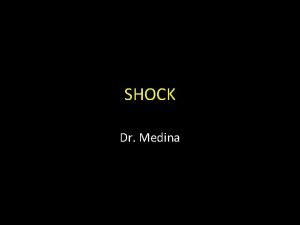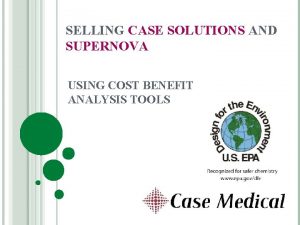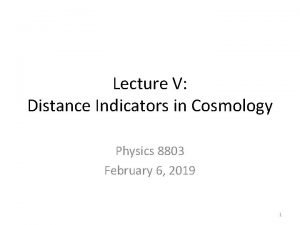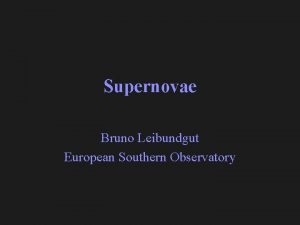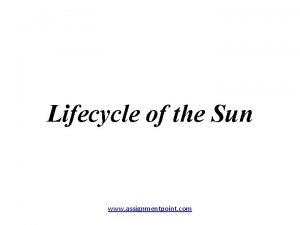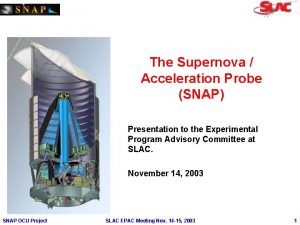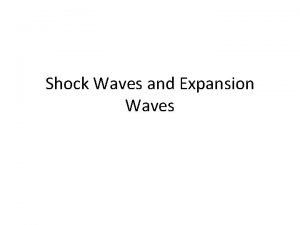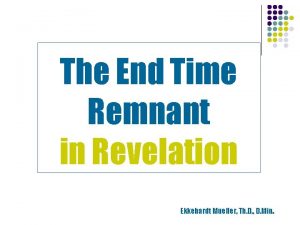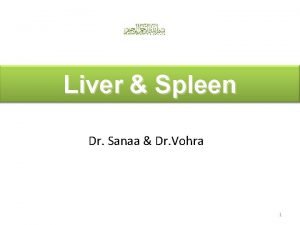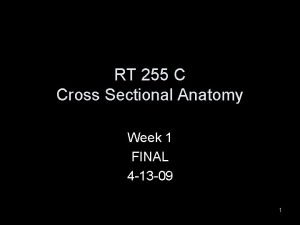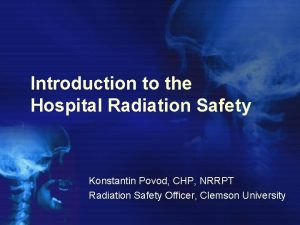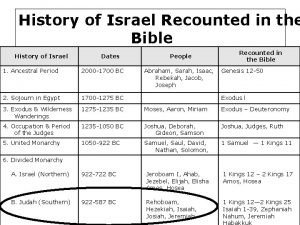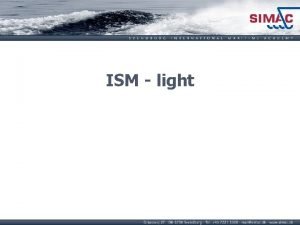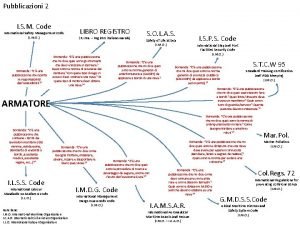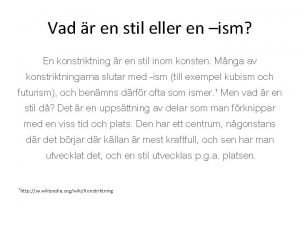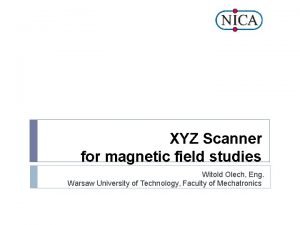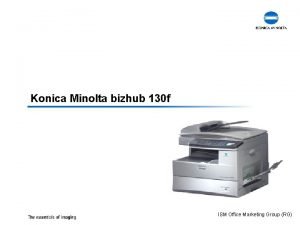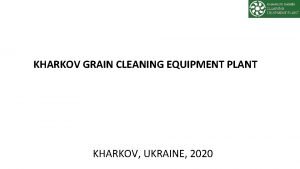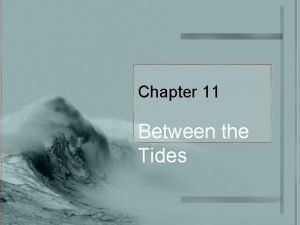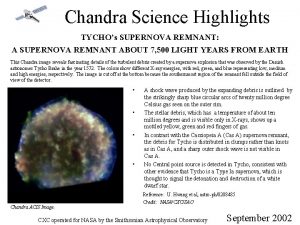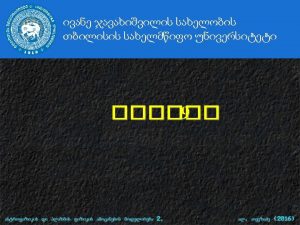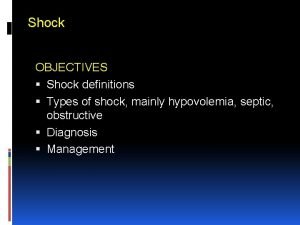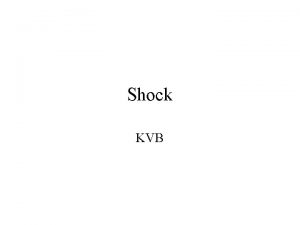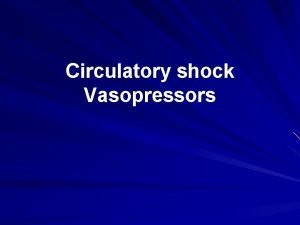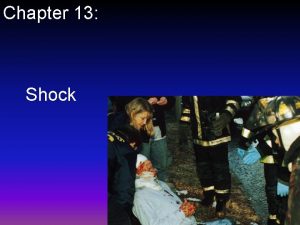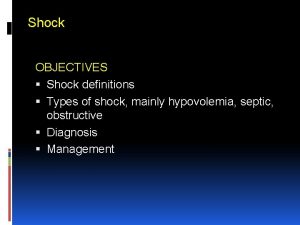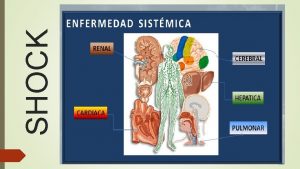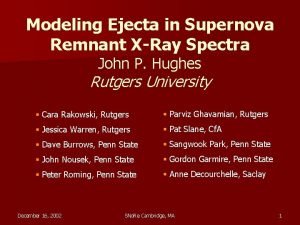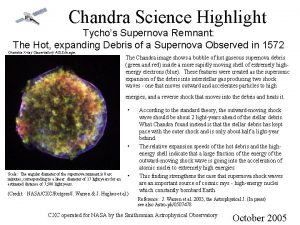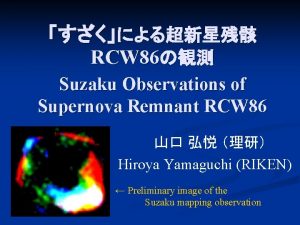ISM Lecture 9 Shock waves Supernova remnant evolution




















































- Slides: 52

ISM Lecture 9 Shock waves; Supernova remnant evolution

9. 1 Shock waves § A shock wave is a pressure-driven compressive disturbance propagating faster than “signal speed” § Shock waves produce an irreversible change in the state of the fluid § Literature: § Landau & Lifshitz, Fluid mechanics, Ch. IV § Dyson & Williams 1997, Ch. 6 + 7 § Tielens, Ch. 11

Sound speed and Mach number § Sound speed: § P = Kργ with γ = 5/3 for adiabatic flow, γ = 1 for isothermal flow § C 1/3 for adiabatic flow sound speed larger in denser gas § for isothermal gas in ISM § Mach number: M ratio of velocity w. r. t. sound speed, M v/C

Steepening of non-linear acoustic wave § speed of crest § speed of trough § § Speed is larger in denser gas Speed of crest is larger than speed of trough Crests “catch up” with troughs Steepening of waveform Steepening halted by viscous forces Development of shock

“Signal speed” in ISM § In the absence of magnetic fields, information travels with sound speed § M < 1 subsonic § M > 1 supersonic shocks § If magnetic field is present, disturbances will travel along B at Alfvén speed v. A: § Interstellar magnetic field (empirical): for 10 < n. H<106 cm-3

Examples of shock waves in the ISM § § § Cloud-cloud collisions Expansion of H II regions Fast stellar winds (“interstellar bubbles”) Supernova blast waves Accretion and outflows during star formation Spiral shocks in Galactic disk

Cloud-cloud collisions shock front v 0 Δv = 2 v 0 5 -10 km/s shocked gas vs v 0

Expansion of H II region compressed neutral gas (cold, high density) H II region ambient neutral gas (cold, medium density) (hot, low density) vs 10 km/s

Fast stellar wind (“Interstellar Bubble”) inner shock outer shock contact discontinuity (wind meets ISM) unshocked wind material shocked cloud material unshocked cloud material

Terminal velocity of wind from hot stars

Supernova blast wave Early: Mswept < Mejecta like stellar wind Late: Mswept >> Mejecta ignore Mejecta shock front hot interior unshocked ISM (cool shell) shocked ISM (did not cool radiatively)

Star formation: infall and outflow shock front hot, shocked accreted matter infalling ambient cold material (low pressure, free fall)

Spiral shocks in Galactic disk flow compressed material forms spiral arm shock front material expands and leaves spiral arm

9. 2 Shock jump conditions § Adopt frame in which shock is stationary § Consider plane-parallel shock: fluid properties depend only on distance x from shock; § Neglect viscosity, except in shock transition zone: large v-gradient viscous dissipation transform bulk kinetic energy into heat irreversible change (entropy increases)

Shock profile (shock frame)

Shock jump conditions (cont’d) § Thickness of shock transition mean free path of particles § This is always << thickness of radiative zone (need collisions to get radiative cooling) § Regard shock thickness as 0 discontinuity § Find physical conditions at 2 (immediately behind shock) or 3 (in post-radiative zone) given those at 1 (pre-shock) and shock velocity vs

Schematic depiction of a radiative shock radiative zone 1. Undisturbed pre-shock material 2. Immediate post-shock conditions 3. Cold post-radiative conditions radiative zone

Mass conservation across shock § § Steady plane-parallel shock: § Integrate across shock:

Momentum conservation across shock § § Note: § no change in gradient of gravitational potential F =>

Energy conservation across shock § Heat conduction Heating Cooling § Same procedure as before ~0 if 1 and 2 are close

Magnetic field equation § The electric field vanishes in the fluid frame § Under this condition the Maxwell Equations can be simplified to give § The last term describes diffusion of the magnetic field and vanishes if the conductivity (ideal MHD)

Special (often used) case: simplifying assumptions § Planar shock: § No heat conduction: § No net heating / cooling: § No gravitational force: § Internal energy density: § B-field flow velocity: § : with g=c. P/c. V

Rankine-Hugoniot equations for shock jump conditions § Follow general practice and write vx=u 1(=v. S) § Mass conservation: § Momentum conservation: § Energy conservation: § Flux conservation:

Solution of shock jump equations § These are the jump conditions: 4 eqs. in 4 unknowns: 2, u 2, P 2, B 2 § Define § Now we have two equations for P 2 and x (cubics in x): § Define Mach number M by M 2=u 12/vms 2 , where vms is the magnetosonic speed given by

Solution of shock jump equations (cont’d) § The trivial solution 1 = 2 always exists § A second solution exists for M > 1 § Strong shock: M >> 1

Some properties of strong shocks § Compression ratio x = 4 § If 16 B 12/8 p<< 1 u 12 and P 1<< 1 u 12 , then momentum conservation gives P 2 3/4 1 u 12=3/4. ram pressure § B 2 = 4 B 1 magnetic pressure increases by factor 16 § Post-shock flow is at P constant, and subsonic:

Adiabatic vs. radiative shocks § So far considered shocks without radiative cooling: “adiabatic shocks” § This is a bad terminology, since shocks are abrupt and irreversible § The term ‘adiabatic’ refers to the fact that no heat is removed during shock § If post-shock gas radiates lines cools down “radiative shock” § If temperature in region 3 is the same as in region 1 “isothermal shock” § This is also a bad terminology since T always rises at shock front

Isothermal shock structure § Solve jump conditions with T 3 = T 1 => 3>> 1 § B = 0: compression factor can become much larger than 4! § B 0: where typical compression factor 100!

J vs. C shocks: MHD effects § So far considered only single-fluid shocks (“Jshocks”) § Normally interstellar gas consists of 3 fluids: (i) neutral particles, (ii) ions, (iii) electrons § Fluids can develop different flow velocities and temperatures § For B 0 information travels by MHD waves § Perpendicular to B the propagation speed is the magnetosonic speed

Magnetic Precursors: C-shocks § Alfvén speed for decoupled ion-electron plasma can be much larger than Alfvén speed for coupled neutral-ionelectron fluid § In many cases: CS<v. A, n < vs < v. A, ie § Ion-electron plasma sends information ahead of disturbance to “inform” pre-shock plasma that compression is coming: magnetic precursor § Compression is sub-sonic and transition is smooth and continuous “C-shock” § Ions couple by collisions to neutrals

Comparison of J-shocks and C-shocks § J (“jump”)-shocks: v. S 50 km/s § § Shock abrupt Neutrals and ions tied into single fluid T high: T 40 (v. S/km s-1)2 Most of radiation in ultraviolet § C (“continuous”)-shocks: v. S 50 km/s § § Gas variables (T, ρ, v) change continuously Ions ahead of neutrals; drag modifies neutral flow Ti Tn; both much lower than in J-shocks Most of radiation in infrared

Schematic structure of J- and C-shocks

C-shock structure Draine & Katz 1986

Post-shock temperature structure of fast J-shock § Three regions: § Hot, UV production § Recombination, Lyα absorption § Molecule formation § Grains are weakly coupled to gas, so that Tgr << Tgas

Computed fine structure line intensities for J-shock

Computed H 2 near-IR line intensities for J-shock

9. 3 Single point explosion in uniform cold medium § Idealized treatment of SN explosion due to Sedov (1959) and Taylor § See also Chevalier (1974) § Equally applicable to atomic bombs § Assumptions: § § E conserved no radiative cooling no charateristic tcool Fluid treatment adequate (mean free path << R) Neglect viscosity, heat conduction Ambient pressure small § Then there is only 1 characteristic § Length: R=size SNR § Time: t=age § Velocity: R/t

Self-similar solution of blast-wave problem § Three characteristic quantities: § Explosion energy E § Ambient density ρ0 § Time since explosion t § Self-similar solution: the space-time evolution of all relevant quantities (ρ, v, T) can be described by universal functions that depend only on one dimensionless parameter § v(r, t) = R/t fv(r/R) § ρ(r, t) = ρ0 fρ (r/R) § T(r, t)=m/k (R/t)2 f. T(r/R)

Dimensional analysis § Use dimensional analysis to determine dependence of R(t) on E, ρ0, t: § § =>

Calculation of A § Expect A~1. To calculate, put in physics § Assume ‘adiabatic’: E=Ekin+Ethermal=const=E 0 § Assume ‘self-similar’: Ekin/Ethermal=const § Behind shock:

More detailed calculation of A § Assume most of mass concentrated just behind shock (O. K. from detailed solution) § Ekin~Ethermal for entire SNR § Ekin~1/2 Mv. S 2, M= 4/3 p. R 3 0 § Then E 0=2 Ekin=2. 1/2. 4/3 p. R 3 0. v. S 2 § R=cst. ta =>v. S=a. cst. ta-1 § => E 0=4/3 p 0(cst)5 a 2 t 5 a-2=const. => a=2/5 => (cst)5=3/(4 p)(5/2)2(E 0/r 0) => (cst)=1. 083 (E 0/ 0)1/5 => A=1. 083 § Exact: A=1. 15169 for g=5/3

Sedov solution § § 50% of mass in outer 6% of radius T P/ρ drops from center towards edge

9. 4 Evolution of SNR in homogeneous ISM 1. Early phase § Early: Mswept < Mejecta (‘Free expansion’) § RS=v. St § v. S v 0=ejecta velocity=(2 E 0/Mejecta)1/2 =10000 km/s (E 0/1051 erg)1/2 (Msun/Mejecta)1/2 § Phase ends at t=t. M when Mswept=Mejecta § For density 0, Mejecta=Mswept= 04/3 p(v 0 t. M)3 =>

2. Sedov phase § Mejecta<Mswept and t<trad

Cooling at end of Sedov phase shock front cool dense shell hot, low density, pressure pi radiative cooling negligible

Estimate of trad § Estimate t=trad when cooling becomes important and Sedov phase ends § Most cooling just behind shock where highest and T lowest § Define trad when 50% of Ethermal radiated almost constant!

3. Post-Sedov or ‘radiative’ phase § Cold dense shell slows down due to sweeping of ISM; momentum is conserved § Naïve snowplow (neglect Pi): R t 1/4

Radiative phase (cont’d) § Pressure-modified snowplow (Oort snowplow): Pi drops due to adiabatic expansion:

4. Merging phase § SNR fades away when expansion velocity = velocity dispersion ambient gas (~10 km/s) § Use Oort snowplow:

Summary phases of supernova shell expansion 1. Early phase (mswept < mejecta): Free expansion, Rs = vs t 2. Sedov phase (mswept > mejecta and t < trad): Energy conservation, R t 2/5 3. Radiative “snowplow” phase (t > trad): Momentum conservation, R t 1/4 or R t 2/7 4. Merging phase: vs drops below velocity dispersion of ambient ISM

Overview of SNR evolution

Overview of SNR evolution
 Spinal shock vs neurogenic shock
Spinal shock vs neurogenic shock Spinal shock vs neurogenic shock
Spinal shock vs neurogenic shock Normovolemico
Normovolemico Spinal shock vs neurogenic shock
Spinal shock vs neurogenic shock T10 spinal cord
T10 spinal cord Supernova
Supernova Supernova spectra
Supernova spectra Bruno leibundgut
Bruno leibundgut Supernova
Supernova Supernova acceleration probe
Supernova acceleration probe Supernova mentor
Supernova mentor Oblique shock angle
Oblique shock angle Hippocampal sulcus remnant cysts
Hippocampal sulcus remnant cysts Remnant radiation
Remnant radiation Fluka tutorial
Fluka tutorial Remnant radiation
Remnant radiation Time remnant
Time remnant Portacaval anastomosis
Portacaval anastomosis Remnant sermon
Remnant sermon Remnant radiation
Remnant radiation Remnant radiation
Remnant radiation Remnant in the bible
Remnant in the bible Ism familiarization
Ism familiarization Ism
Ism What is ism
What is ism What is integrated service management
What is integrated service management Ism code cos'è
Ism code cos'è Ism r
Ism r Cpsm exam 2
Cpsm exam 2 Systemic mastocytosis
Systemic mastocytosis Witold olech
Witold olech Ism office
Ism office Grain cleaning plant
Grain cleaning plant 01:640:244 lecture notes - lecture 15: plat, idah, farad
01:640:244 lecture notes - lecture 15: plat, idah, farad Differences between constructive and destructive waves
Differences between constructive and destructive waves What type of waves are sound waves? *
What type of waves are sound waves? * Mechanical waves vs electromagnetic waves
Mechanical waves vs electromagnetic waves Is a seismic wave mechanical or electromagnetic
Is a seismic wave mechanical or electromagnetic Light is an electromagnetic wave true or false
Light is an electromagnetic wave true or false Is echolocation transverse or longitudinal
Is echolocation transverse or longitudinal Compare and contrast p waves and s waves using venn diagram
Compare and contrast p waves and s waves using venn diagram Mechanical and electromagnetic waves similarities
Mechanical and electromagnetic waves similarities What are the mechanical waves
What are the mechanical waves Long waves and short waves
Long waves and short waves Mechanical and electromagnetic waves
Mechanical and electromagnetic waves Seismic waves
Seismic waves Similarities of mechanical waves and electromagnetic waves
Similarities of mechanical waves and electromagnetic waves Mechanical waves and electromagnetic waves similarities
Mechanical waves and electromagnetic waves similarities Difference between electromagnetic and mechanical waves
Difference between electromagnetic and mechanical waves Class of shock
Class of shock 17:6 providing first aid for burns
17:6 providing first aid for burns Wave shock marine biology
Wave shock marine biology Aggregate supply equation
Aggregate supply equation


